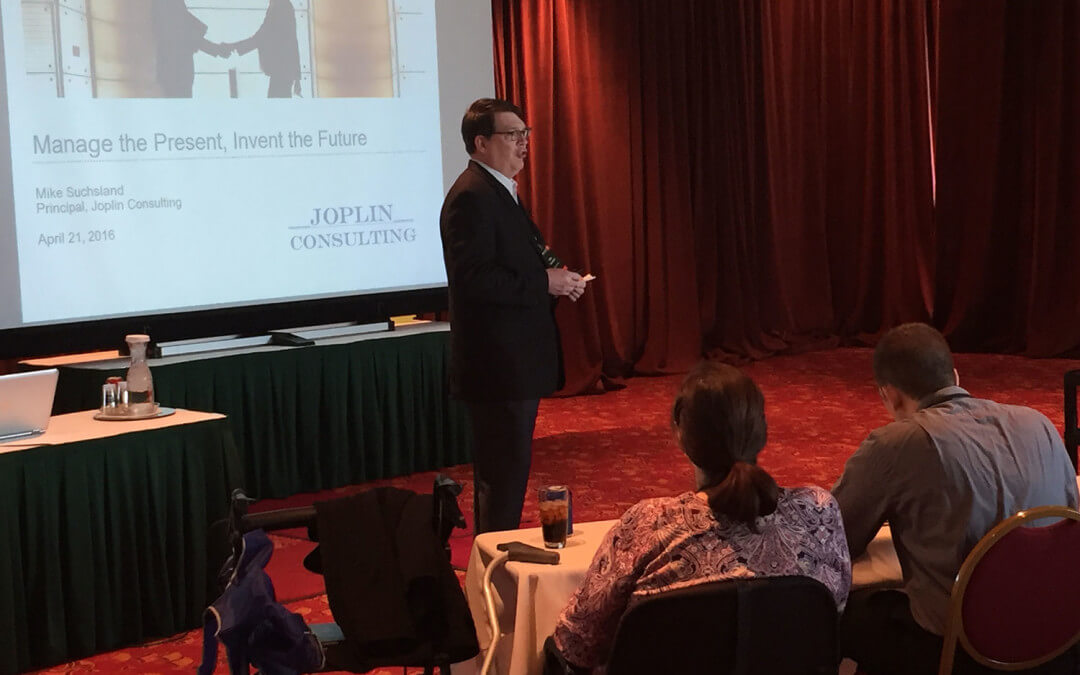CI leaders will overcome challenges by developing trust and respect through engagement at all levels of the organization
RECONVERGE:G2 started Thursday morning April 21 with a look ahead as Mike Suchsland of Joplin Consulting delivered his presentation, “Manage the Present, Invent the Future,” as an executive—not a CI practitioner–who spoke about how we can effectively communicate and contribute to successes at our companies.
Suchsland spoke about leadership challenges and provided case studies of leadership lessons that can be applied in the CI environment.
We think about managing the present and inventing the future—but we also need to think about “forgetting the past.” Suchsland foresees the role of CI as one that is not merely informing executives, but participating in the transformation of the organization.
Do we consider ourselves leaders? We assume that leadership is implied by hierarchy. His definition is outside the range of hierarchy to include any individual who can persuade others to a point of view, motivate and energize, and enable people to work toward a broader vision.
CI is in a unique position to care about the future of organizations.
Leadership challenges
- Homogeneity
- Cynicism
- Conformity
- Hierarchy
“Effective leadership excites people to create change.”
What is different about you that might excite others to create change? Perhaps it is not a personal quality, but something that is based upon your position within the organization: access to data, an ability to frame issues, your network of contacts, and so on.
One example of an effective leader is Ernest Shackleton, Antarctic explorer. Despite his failed attempts, Shackleton has a reputation as an outstanding leader because of the way he handled crisis and helped his crew overcome dire circumstances.
Shackleton solicited his crew with honest explanation of the danger surrounding the trip, and described in detail the brave and adventuresome qualities this team would possess. The message Shackleton sent implied honesty and teamwork would be part of the deal and that results of a successful endeavor would be fame and fortune for his crew.
Within teams, two most valued things are trust and results. Also important are sense of direction, belonging, learning and growth.
Leadership framework
- Manage the present: Honest and candid. Explain the why, interact genuinely. “Walk the walls and cover the cubes,” collect and share knowledge and become a facilitator.
- Selectively forget the past: Be respectful and reverent. Gather and share, discuss and debate. Know that benchmarking is more than providing raw data; it is the synthesis of hypothesis and conclusions. A better approach would be to summarize circumstances with explanation of successes, challenges, and suggested action steps to manage problem issues.
- Invent the future: Optimistic and energetic. Incorporate feedback, enable support. Netflix provides an interesting case study. Initially there was no ‘’on demand” component, eventually some content was converted to streaming media. They did survey the environment and identify opportunity—the developed their own programming, reinvigorated canceled programs from other entities, and currently are seeking international activity to compete with Amazon and Hulu. This is a forward-looking company.
Organizations that accomplish these leadership feats successfully are great role models.
The competitive intelligence voice
Benchmarking is overcoming homoegeneity, cynicism, conformity, hierarchy with:
- Genuine interaction
- Truth-telling
- Context
- On-boarding
- Optimism
Effective vs less effective leaders
Drive trust and results, utilizing competitive intelligence to accomplish change.
